This 3,500-Year-Old Greek Tomb Upended What We Thought We Knew About the Roots of Western Civilization
The recent discovery of the grave of an ancient soldier is challenging accepted wisdom among archaeologists
:focal(2878x3949:2879x3950)/https://tf-cmsv2-smithsonianmag-media.s3.amazonaws.com/filer/49/0f/490f7d26-a2e4-4384-8625-78fdce99dd78/janfeb2017_l04_greekwarrior.jpg)
They had been digging for days, shaded from the Greek sun by a square of green tarpaulin slung between olive trees. The archaeologists used picks to break the cream-colored clay, baked as hard as rock, until what began as a cluster of stones just visible in the dirt became four walls in a neat rectangle, sinking down into the earth. Little more than the occasional animal bone, however, came from the soil itself. On the morning of May 28, 2015, the sun gave way to an unseasonable drizzle. The pair digging that day, Flint Dibble and Alison Fields, waited for the rain to clear, then stepped down into their meter-deep hole and got to work. Dibble looked at Fields. “It’s got to be soon,” he said.
The season had not started well. The archaeologists were part of a group of close to three dozen researchers digging near the ancient Palace of Nestor, on a hilltop near Pylos on the southwest coast of Greece. The palace was built in the Bronze Age by the Mycenaeans—the heroes described in Homer’s epic poems—and was first excavated in the 1930s. The dig’s leaders, Jack Davis and Sharon Stocker, husband-and-wife archaeologists from the University of Cincinnati, in Ohio, had hoped to excavate in a currant field just downslope from the palace, but Greek bureaucracy and a lawyers’ strike kept them from obtaining the necessary permits. So they settled, disappointed, on a neighboring olive grove. They cleared the land of weeds and snakes and selected a few spots to investigate, including three stones that appeared to form a corner. As the trench around the stones sank deeper, the researchers allowed themselves to grow eager: The shaft’s dimensions, two meters by one meter, suggested a grave, and Mycenaean burials are famous for their breathtakingly rich contents, able to reveal volumes about the culture that produced them. Still, there was no proof that this structure was even ancient, the archaeologists reminded themselves, and it might simply be a small cellar or shed.
Dibble was clearing earth from around a large stone slab when his pick hit something hard and the monotony of the clay was broken by a vivid flash of green: bronze.
The pair immediately put down their picks, and after placing an excited call to Davis and Stocker they began to carefully sweep up the soil and dust. They knew they were standing atop something substantial, but even then they did not imagine just how rich the discovery would turn out to be.“It was amazing,” says Stocker, a small woman in her 50s with dangling earrings and blue-gray eyes. “People had been walking across this field for three-and-a-half-thousand years.”
Over the next six months, the archaeologists uncovered bronze basins, weapons and armor, but also a tumble of even more precious items, including gold and silver cups; hundreds of beads made of carnelian, amethyst, amber and gold; more than 50 stone seals intricately carved with goddesses, lions and bulls; and four stunning gold rings. This was indeed an ancient grave, among the most spectacular archaeological discoveries in Greece in more than half a century—and the researchers were the first to open it since the day it was filled in.
“It’s incredible luck,” says John Bennet, director of the British School at Athens. “The fact that it hadn’t been discovered before now is astonishing.” The spectacular find of priceless treasures made headlines around the globe, but what really intrigues scholars, says Stocker, is the “bigger world picture.” The very first organized Greek society belonged to the Mycenaeans, whose kingdoms exploded out of nowhere on the Greek mainland around 1600 B.C. Although they disappeared equally dramatically a few hundred years later, giving way to several centuries known as the Greek Dark Ages, before the rise of “classical” Greece, the Mycenaeans sowed the seeds of our common traditions, including art and architecture, language, philosophy and literature, even democracy and religion. “This was a crucial time in the development of what would become Western civilization,” Stocker says.
Yet remarkably little is known of the beginnings of Mycenaean culture. The Pylos grave, with its wealth of undisturbed burial objects and, at its bottom, a largely intact skeleton, offers a nearly unprecedented window into this time—and what it reveals is calling into question our most basic ideas about the roots of Western civilization.
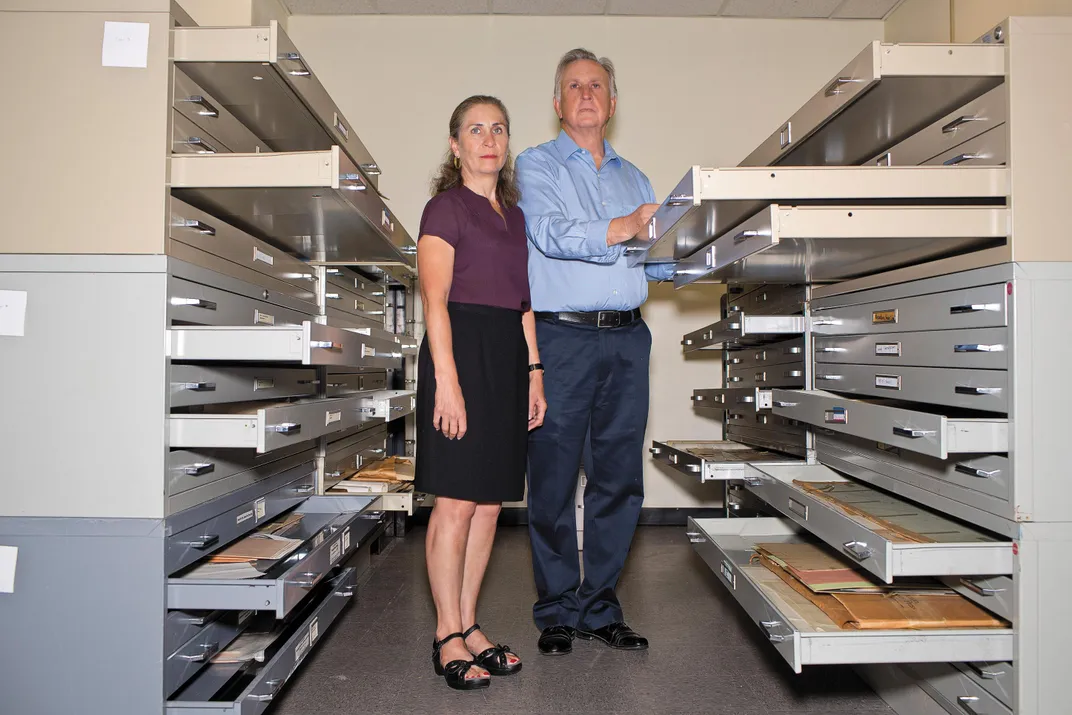
**********
In The Iliad, Homer tells of how Agamemnon, king of Mycenae, led a fleet of a thousand ships to besiege the city of Troy. Classical Greeks (and Romans, who traced their heritage to the Trojan hero Aeneas) accepted the stories in The Iliad and The Odyssey as a part of their national histories, but in later centuries scholars insisted that the epic battles fought between the Trojan and Mycenaean kingdoms were nothing more than myth and romantic fantasy. Before the eighth century B.C., archaeologists argued, societies on the Greek mainland were scattered and disorganized.
At the end of the 19th century, a German-born businessman named Heinrich Schliemann was determined to prove otherwise. He used clues in Homer’s epic poems to locate the remains of Troy, buried in a hillside at Hissarlik in Turkey. He then turned his attention to the Greek mainland, hoping to find the palace of Agamemnon. Near the ruins of the great walls at Mycenae, in the Argolid Peninsula, Schliemann found a circle of graves containing the remains of 19 men, women and children, all dripping with gold and other riches. He hadn’t found Agamemnon—the graves, nearly 3,500 years old, dated to several centuries before the battles of Troy—but he had unearthed a great, lost civilization, which he called the Mycenaean, after the sovereign city of the powerful mythic king.
Homer describes other palaces, too, notably that of King Nestor, at Pylos. The Iliad says Nestor contributed 90 ships to Agamemnon’s fleet, second only to the great leader himself. Schliemann searched in vain for Nestor’s palace; in modern Pylos, a sleepy coastal town in the southwest Peloponnese, there was no hint of ancient architecture, unlike at Mycenae. But in the 1920s, a landowner noticed old stone blocks near the summit of a hill near Pylos, and Konstantinos Kourouniotis, director of the National Archaeological Museum in Athens, invited his friend and collaborator Carl Blegen, of the University of Cincinnati, to investigate.
Blegen began excavations in April 1939. On his very first day, he uncovered a hoard of clay tablets, filled with an unreadable script known as Linear B, which had also been found on Crete, the largest of the Aegean islands. He had dug straight into the archive room of King Nestor’s palace. After World War II, Blegen went on to discover a grid of rooms and courtyards that rivals Mycenae in size and is now the best-preserved Bronze Age palace on the Greek mainland, not to mention a significant tourist attraction.
Today, Blegen’s work at Pylos is continued by Stocker and Davis (his official title is the Carl W. Blegen professor of Greek archaeology). Davis walks with me to the hilltop, and we pause to enjoy the gorgeous view of olive groves and cypress trees rolling down to a jewel-blue sea. Davis has white-blond hair, freckles and a dry sense of humor, and he is steeped in the history of the place: Alongside Stocker, he has been working in this area for 25 years. As we look out to sea, he points out the island of Sphacteria, where the Athenians beat the Spartans during a fifth-century B.C. battle of the Peloponnesian War.
Behind us, Nestor’s palace is surrounded by flowering oleander trees and is covered with an impressive new metal roof, completed just in time for the site’s reopening to the public in June 2016 after a three-year, multimillion-euro restoration. The roof’s graceful white curves protect the ruins from the elements, while a raised walkway allows visitors to admire the floor plan. The stone walls of the palace now rise just a meter from the ground, but it was originally a vast two-story complex, built around 1450 B.C., that covered more than 15,000 square feet and was visible for miles. Visitors would have passed through an open courtyard into a large throne room, Davis explains, with a central hearth for offerings and decorated with elaborately painted scenes including lions, griffins and a bard playing a lyre.
The Linear B tablets found by Blegen, deciphered in the 1950s, revealed that the palace was an administrative center that supported more than 50,000 people in an area covering all of modern-day Messenia in western Greece. Davis points out storerooms and pantries in which thousands of unused ceramic wine cups were found, as well as workshops for the production of leather and perfumed oils.
Echoes of Homer are everywhere. In The Odyssey, when Odysseus’ son Telemachus visits Pylos, he finds the inhabitants on the shore sacrificing bulls to the god Poseidon, before traveling to the palace to receive a bath from one of Nestor’s daughters. Tablets and animal bones that Blegen found in the archives room recall a feast in which 11 cattle were sacrificed to Poseidon, while on the other side of the building is a perfectly preserved terra-cotta bathtub, its interior painted with a repeating spiral motif.
The palace was destroyed in a fire around 1200 B.C., part of a wave of destruction that brought down the entire Mycenaean society, which in a few hundred years had developed distinctive art and architecture, its own writing system, a powerful military and trading routes that stretched across the known world. Scholars argue about what brought about the culture’s collapse, but drought, famine and invasion may all have played a role.
Davis and Stocker are interested not in the ruination of the palace, however, but in its beginnings. For several hundred years before the palace was built, the region was dominated by the Minoans, whose sophisticated civilization arose on Crete, with skilled artisans and craftsmen who traded widely in the Aegean, Mediterranean and beyond. By contrast, the people of mainland Greece, a few hundred miles to the north across the Kythera Strait, lived simple lives in small settlements of mud-brick houses, quite unlike the impressive administrative centers and well-populated Cretan villages at Phaistos and Knossos, the latter home to a maze-like palace complex of over a thousand interlocking rooms. “With no sign of wealth, art or sophisticated architecture, mainland Greece must have been a pretty depressing place to live,” says Davis. “Then, everything changes.”
Around 1600 B.C., the mainlanders began leaving almost unimaginable treasures in tombs—“a sudden splash of brilliance,” in the words of Louise Schofield, the archaeologist and former British Museum curator, describing the jewelry, weapons and golden death masks discovered by Schliemann in the graves at Mycenae. The mainland population swelled; settlements grew in size, number and apparent wealth, with ruling elites becoming more cosmopolitan, exemplified by the diverse riches they buried with their dead. At Pylos, a huge, beehive-shaped stone tomb known as a tholos was constructed, connected to mansion houses on the hilltop by a ceremonial road that led through a gateway in a surrounding fortification wall. Although thieves looted the tholos long before it was rediscovered in modern times, from what was left behind—seal stones, miniature gold owls, amethyst beads—it appears to have been stuffed with valuables to rival those at Mycenae.
This era, extending until the construction of palaces at Pylos, Mycenae and elsewhere, is known to scholars as the “shaft grave period” (after the graves that Schliemann discovered). Cynthia Shelmerdine, a classicist and renowned scholar of Mycenaean society at the University of Texas at Austin, describes this period as “the moment the door opens.” It is, she says, “the start of elites coming together to form something beyond just a minor chiefdom, the very beginning of what leads to the palatial civilization only a hundred years later.” From this first awakening, “it really takes a very short time for them to leap into full statehood and become great kings on a par with the Hittite emperor. It was a remarkable thing to happen.”
Yet partly as a result of the building of the palaces themselves, atop the razed mansions of early Mycenaeans, very little is known of the people and culture that gave birth to them. You can’t just tear up the plaster floors to see what’s underneath, Davis explains. The tholos itself went out of use around the time the palace was built. Whoever the first leaders here were, Davis and Stocker had assumed, they were buried in this plundered tomb. Until, less than a hundred yards from the tholos, the researchers found the warrior grave.
**********
Davis and Stocker disagree on where they were when they received Dibble’s call from the dig site. Stocker remembers they were at the team’s workshop. Davis thinks they were at the local museum. Dibble recalls that they were in line at the bank. Whichever it was, they rushed to the site and, Stocker says, “basically never left.”
That first splash of green became an ocean, filled with layer after layer of bronze, reminiscent of Schliemann’s magnificent finds. “It was surreal,” says Dibble. “I felt like I was in the 19th century.”
The researchers celebrated the next day with a lunch of gourounopoulo (roast suckling pig) from the local farmer’s market, eaten under the olive trees. For Davis and Stocker, the challenge of the find soon set in. “Everything was interlocked, crushed with everything else,” says Davis. “We never imagined that we might find anything more than a few potsherds that could be put together with glue. Suddenly, we were faced with this huge mess.” The collaborators began working 15-hour shifts, hoping to clear the site as quickly as possible. But after two weeks, everyone was exhausted. “It became clear that we couldn’t continue at that pace, and we weren’t going to finish,” Stocker says. “There was too much stuff.”
About a week in, Davis was excavating behind the stone slab. “I’ve found gold,” he said calmly. Stocker thought he was teasing, but he turned around with a golden bead in his palm. It was the first in a flood of small, precious items: beads; a tiny gold birdcage pendant; intricately carved gold rings; and several gold and silver cups. “Then things changed,” says Stocker. Aware of the high risk of looting, she organized round-the-clock security, and, apart from the Ministry of Culture and the site’s head guard, the archaeologists agreed to tell no one about the more valuable finds. They excavated in pairs, always with one person on watch, ready to cover precious items if someone approached.
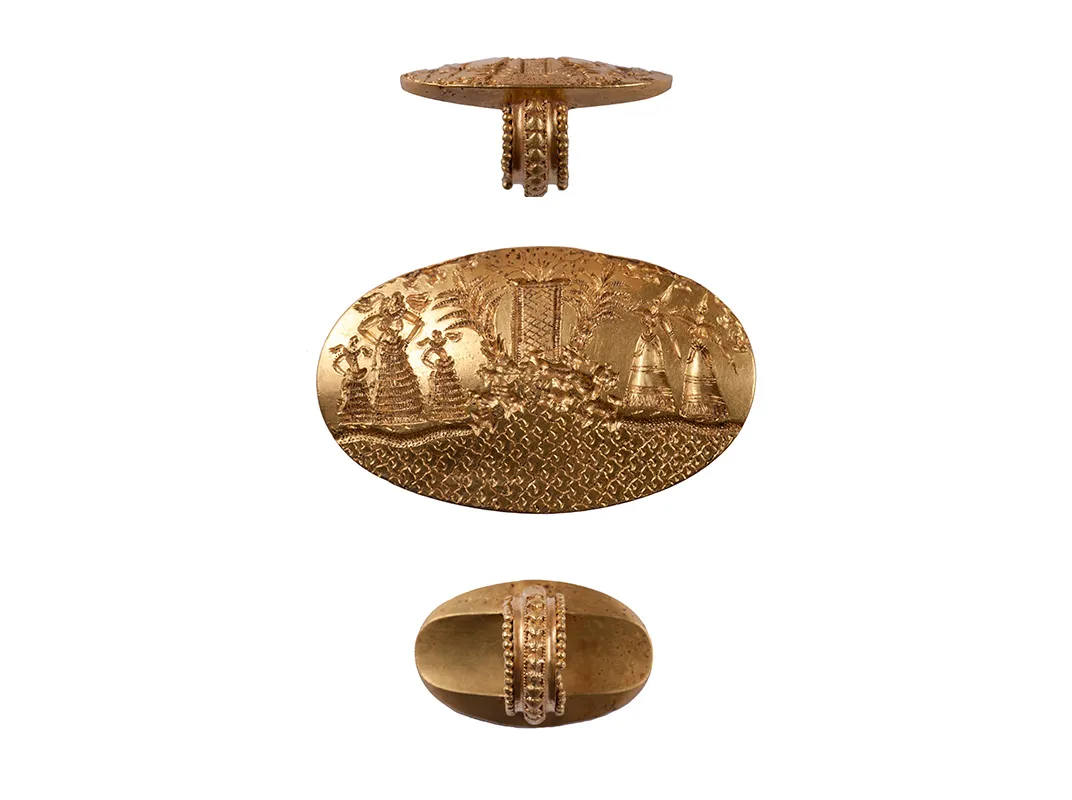
And yet it was impossible not to feel elated, too. “There were days when 150 beads were coming out—gold, amethyst, carnelian,” says Davis. “There were days when there was one seal stone after another, with beautiful images. It was like, Oh my god, what will come next?!” Beyond the pure thrill of uncovering such exquisite items, the researchers knew that the complex finds represented an unprecedented opportunity to piece together this moment in history, promising insights into everything from religious iconography to local manufacturing techniques. The discovery of a golden cup, as lovely as the day it was made, proved an emotional moment. “How could you not be moved?” says Stocker. “It’s the passion of looking at a beautiful piece of art or listening to a piece of music. There’s a human element. If you forget that, it becomes an exercise in removing things from the ground.”
In late June 2015, the scheduled end to their season came and went, and a skeleton began to emerge—a man in his early 30s, his skull flattened and broken and a silver bowl on his chest. The researchers nicknamed him the “griffin warrior” after a griffin-decorated ivory plaque they found between his legs. Stocker got used to working alongside him in that cramped space, day after day in the blazing summer sun. “I felt really close to this guy, whoever he was,” she says. “This was a person and these were his things. I talked to him: ‘Mr. Griffin, help me to be careful.’”
In August, Stocker ended up in the local medical clinic with heatstroke. In September, she was rewarded with a gold-and-agate necklace that the archaeologists had spent four months trying to liberate from the earth. The warrior’s skull and pelvis were among the last items to be removed, lifted out in large blocks of soil. By November, the grave was finally empty. Every gram of soil had been dissolved in water and passed through a sieve, and the three-dimensional location of every last bead photographed and recorded.
Seven months later, Stocker sails through a low, green metal door into the basement of the archaeological museum in the small town of Chora, a few minutes’ drive from the palace. Inside, the room is packed with white tables, wooden drawers, and countless shelves of skulls and pots: the results of decades of excavations in this region.
Still the organizational force behind the Pylos project, Stocker looks after not just the human members of the team but a troupe of adopted animals, including the mascot, a sleek gray cat named Nestor, which she rescued from the middle of the road when he was 4 weeks old. “He was teeny,” she recalls. “One day he blew off the table.”
She’s also in charge of conservation. Around her, plastic boxes of all sizes are piled high, full of artifacts from the warrior’s grave. She opens box after box to show their contents—one holds hundreds of individually labeled plastic bags, each containing a single bead. Another yields seal stones carved with intricate designs: three reclining bulls; a griffin with outstretched wings. “I still can’t believe I’m actually touching them,” she says. “Most people only see things like this through glass in a museum.”
There are delicate ivory combs, thin bands of bronze (the remains of the warrior’s armor) and boar tusks likely from his helmet. From separate wrappings of acid-free paper she reveals a bronze dagger, a knife with a large, square blade (perhaps used for sacrifices) and a great bronze sword, its hilt decorated with thousands of minute fragments of gold. “It’s truly amazing, and in bad shape,” she says. “It’s one of our highest priorities.”
There are more than 1,500 objects in all, and although the most precious items aren’t here (they are under lock-and-key elsewhere), the scale of the task she faces to preserve and publish these objects is nearly overwhelming. She surveys the room: a life’s work mapped out before her.
“The way they dug this grave is just remarkable,” says Thomas Brogan, the director of the Institute for Aegean Prehistory Study Center for East Crete. “I think the sky’s the limit in terms of what we are going to learn.”
**********
Fragments of Ancient Life
From jewelry to gilded weapons, a sampling of the buried artifacts researchers are using to fill in the details about the social currents in Greece at the time the griffin warrior lived
By 5W Infographics; Research by Virginia Mohler

**********
Like any momentous archaeological find, the griffin warrior’s grave has two stories to tell. One is the individual story of this man—who he was, when he lived, what role he played in local events. The other story is broader—what he tells us about the larger world and the crucial shifts in power taking place at that moment in history.
Analyses of the skeleton show that this 30-something dignitary stood around five-and-a-half feet, tall for a man of his time. Combs found in the grave imply that he had long hair. And a recent computerized facial reconstruction based on the warrior’s skull, created by Lynne Schepartz and Tobias Houlton, physical anthropologists at the University of the Witwatersrand in Johannesburg, shows a broad, determined face with close-set eyes and a prominent jaw. Davis and Stocker are also planning DNA tests and isotope analyses that they hope will provide information about his ethnic and geographic origins.
At first, the researchers struggled to precisely date his burial. Soil layers are usually dated based on the shifting styles of ceramics; this grave held no pottery at all. But excavations of the grave’s surrounding soil in the summer of 2016 turned up pottery sherds that point to an archaeological period roughly corresponding to 1500-1450 B.C. So the warrior lived at the very end of the shaft grave period, just before construction of the Mycenaean palaces, including Nestor’s.
Davis and Stocker believe that the tholos tomb at Pylos was still in use at this time. If the warrior was in fact an important figure, perhaps even a leader, why was he buried in a separate shaft grave, and not in the tholos? Stocker wonders whether digging the shaft grave may say something about the manner of the warrior’s death—that it was unexpected—and proved a quicker option than deconstructing and rebuilding the entrance to the tholos. Bennet, on the other hand, speculates that contrasting burial practices in such close proximity may represent separate local family groups vying for supremacy. “It’s part of a power play,” he says. “We have people competing with each other for display.” To him, competition to amass exotic materials and knowledge may have been what drove the social development of Mycenaean ruling elites.
Within a few years of the warrior’s burial, the tholos went out of use, the gateway in the fortification wall closed, and every building on the hilltop was destroyed to make way for the new palace. On Crete, Minoan palaces across the island burned along with many villas and towns, although precisely why they did remains unknown. Only the main center of Knossos was restored for posterity, but with its art, architecture and even tombs adopting a more mainland style. Its scribes switched from Linear A to Linear B, using the alphabet to write not the language of the Minoans, but Mycenaean Greek. It’s a crucial transition that archaeologists are desperate to understand, says Brogan. “What brings about the collapse of the Minoans, and at the same time what causes the emergence of the Mycenaean palace civilization?”
The distinctions between the two societies are clear enough, quite apart from the fundamental difference in their languages. The Mycenaeans organized their towns with free-standing houses rather than the conglomerated shared buildings seen on Crete, for example. But the relationship between the peoples has long been a contentious subject. In 1900, just 24 years after Schliemann announced he’d found Homer’s heroes at Mycenae, the British archaeologist Arthur Evans discovered the Minoan civilization (named for Crete’s mythic King Minos) when he unearthed Knossos. Evans and subsequent scholars argued that the Minoans, and not the Mycenaean mainlanders, were the “first” Greeks—“the first link in the European chain,” according to the historian Will Durant. Schliemann’s graves, the thinking went, belonged to wealthy rulers of Minoan colonies established on the mainland.
In 1950, however, scholars finally deciphered Linear B tablets from Knossos and Pylos and showed the writing to be the earliest known form of Greek. Opinion now swung the other way: The Mycenaeans were reinstated as the first Greeks, and Minoan objects found in mainland graves were reinterpreted as status symbols stolen or imported from the island. “It’s like the Romans copying Greek statues and carting them off from Greece to put in their villas,” says Shelmerdine.
And this has been the scholarly consensus ever since: The Mycenaeans, now thought to have sacked Knossos at around the time they built their mainland palaces and established their language and administrative system on Crete, were the true ancestors of Europe.
**********
The griffin warrior’s grave at Pylos offers a radical new perspective on the relationship between the two societies and thus on Europe’s cultural origins. As in previously discovered shaft graves, the objects themselves are a cross-cultural mix. For instance, the boar tusk helmet is typically Mycenaean, but the gold rings, which are rich with Minoan religious imagery and are on their own a hugely significant find for scholars, says Davis, reflect artifacts previously found on Crete.
Unlike ancient graves at Mycenae and elsewhere, however, which held artifacts from different individuals and time periods, the Pylos grave is an undisturbed single burial. Everything in it belonged to one person, and archaeologists can see precisely how the grave goods were positioned.
Significantly, weapons had been placed on the left side of the warrior’s body while rings and seal stones were on the right, suggesting that they were arranged with intent, not simply thrown in. The representational artwork featured on the rings also had direct connections to actual buried objects. “One of the gold rings has a goddess standing on top of a mountain with a staff that seems to be crowned by a horned bull’s head,” says Davis. “We found a bull’s head staff in the grave.” Another ring shows a goddess sitting on a throne, looking at herself in the mirror. “We have a mirror.” Davis and Stocker do not believe that all this is a coincidence. “We think that objects were chosen to interact with the iconography of the rings.”
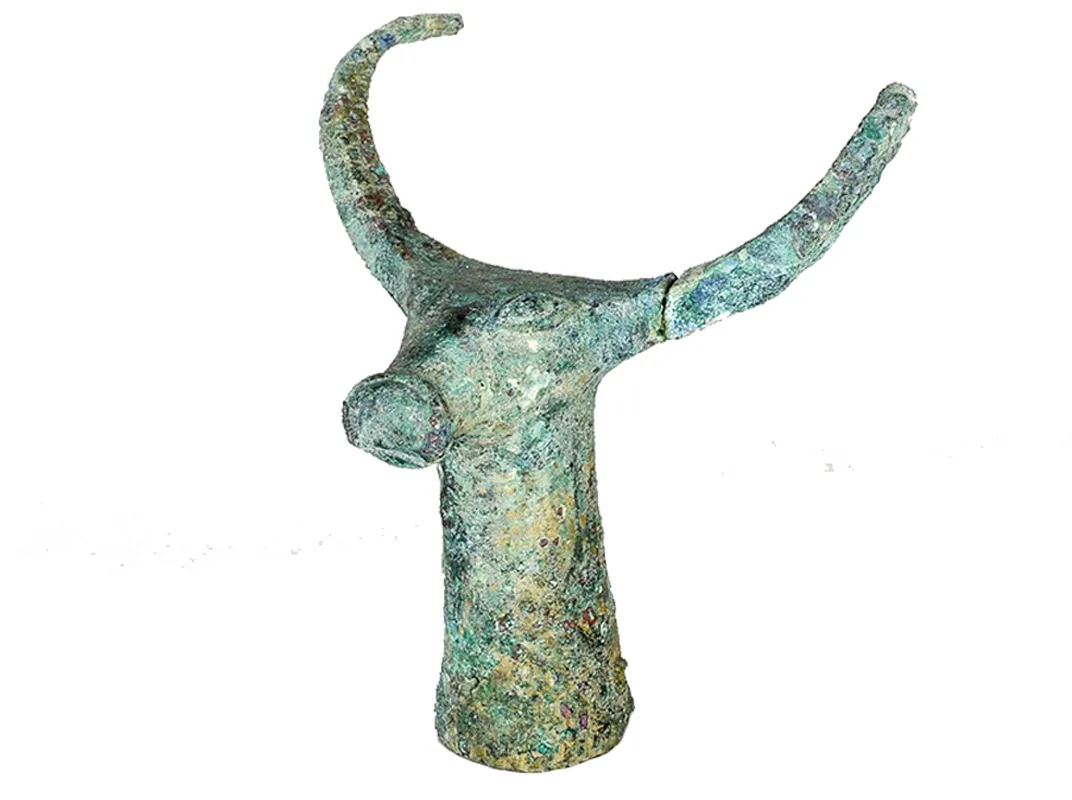
In their view, the arrangement of objects in the grave provides the first real evidence that the mainland elite were experts in Minoan ideas and customs, who understood very well the symbolic meaning of the products they acquired. “The grave shows these are not just knuckle-scraping, Neanderthal Mycenaeans who were completely bowled over by the very existence of Minoan culture,” says Bennet. “They know what these objects are.”
New discoveries made by Davis and Stocker just this past summer provide more striking evidence that the two cultures had more in common than scholars have realized. Among the finds are remnants from what are likely the oldest wall paintings ever found on the Greek mainland. The fragments, which measure between roughly one and eight centimeters across and may date as far back as the 17th century B.C., were found beneath the ruins of Nestor’s Palace. The researchers speculate that the paintings once covered the walls of mansion houses on the site before the palace was built. Presumably, the griffin warrior lived in one of those mansions.
Moreover, small sections of pieced-together fragments indicate that many of the paintings were Minoan in character, showing nature scenes, flowering papyri and at least one miniature flying duck, according to Emily Egan, an expert in eastern Mediterranean art at the University of Maryland at College Park who worked on the excavations and is helping to interpret the finds. That suggests, she says, a “very strong connection with Crete.”
Together, the grave goods and the wall paintings present a remarkable case that the first wave of Mycenaean elite embraced Minoan culture, from its religious symbols to its domestic décor. “At the very beginning, the people who are going to become the Mycenaean kings, the Homeric kings, are sophisticated, powerful, rich and aware of something beyond the world that they are emerging from,” says Shelmerdine.
This has led Davis and Stocker to favor the idea that the two cultures became entwined at a very early stage. It’s a conclusion that fits recent suggestions that regime change on Crete around the time the mainland palaces went up, which traditionally corresponds to the decline of Minoan civilization, may not have resulted from the aggressive invasion that historians have assumed. The later period on Knossos might represent something more like “an EU in the Aegean,” says Bennet, of the British School at Athens. Minoans and Mycenaean Greeks would surely have spoken each other’s languages, may have intermarried and likely adopted and refashioned one another’s customs. And they may not have seen themselves with the rigid identities we moderns have tended to impose on them.
In other words, it isn’t the Mycenaeans or the Minoans to whom we can trace our cultural heritage since 1450 B.C., but rather a blending of the two.
The fruits of that intermingling may have shaped the culture of classical Greece and beyond. In Greek mythology, for example, the legendary birthplace of Zeus is said to be a cave in the Dicte mountains on Crete, which may derive from a story about a local deity worshiped at Knossos. And several scholars have argued that the very notion of a Mycenaean king, known as a wanax, was inherited from Crete. Whereas the Near East featured autocratic kings—the Egyptian pharaoh, for example, whose supposed divine nature set him apart from earthly citizens—the wanax, says Davis, was the “highest-ranking member of a ranked society,” and different regions were served by different leaders. It’s possible, Davis proposes, that the transfer to Greek culture of this more diffuse, egalitarian model of authority was of fundamental importance for the development of representative government in Athens a thousand years later. “Way back in the Bronze Age,” he says, “maybe we’re already seeing the seeds of a system which ultimately allows for the emergence of democracies.”
The revelation is compelling for anyone with an interest in how great civilizations are born—and what makes them “great.” And with rising nationalism and xenophobia in parts of Europe and the United States, Davis and others suggest that the grave contains a more urgent lesson. Greek culture, Davis says, “is not something that has been genetically transmitted from generation to generation since the dawn of time.” From the very earliest moments of Western civilization, he says, Mycenaeans “were capable of embracing many different traditions.”
“I think we should all care about that,” says Shelmerdine. “It resonates today, when you have factions that want to throw everybody out [of their countries]. I don’t think the Mycenaeans would have gotten anywhere if they hadn’t been able to reach beyond their shores.”
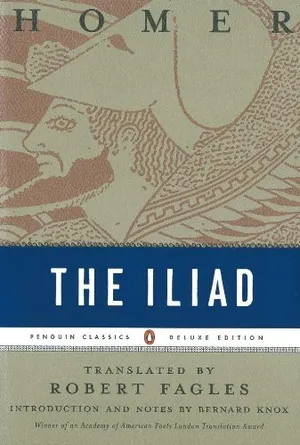
The Iliad
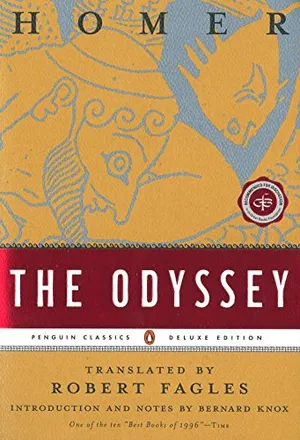
The Odyssey
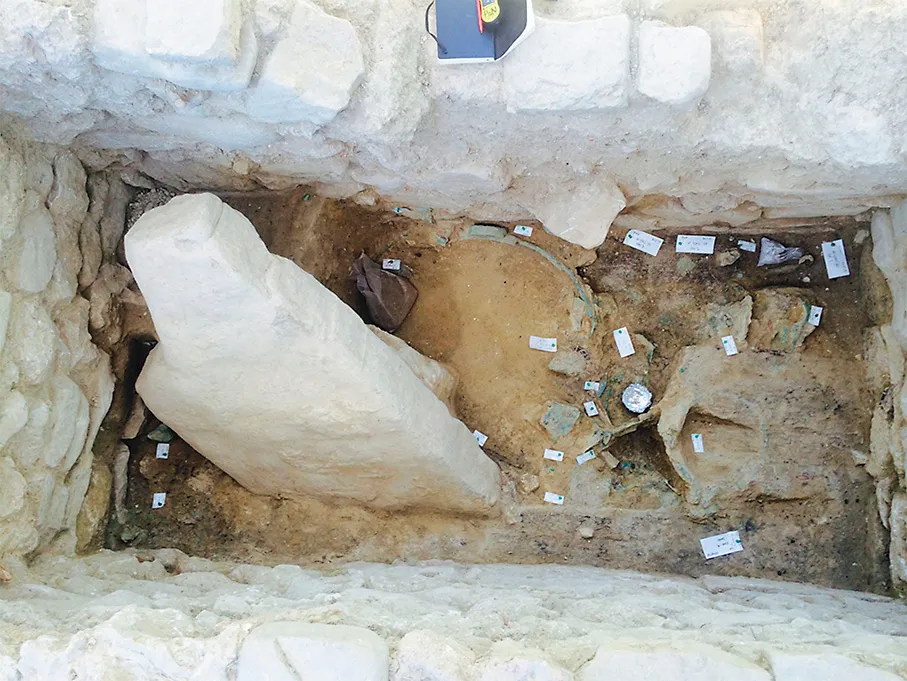
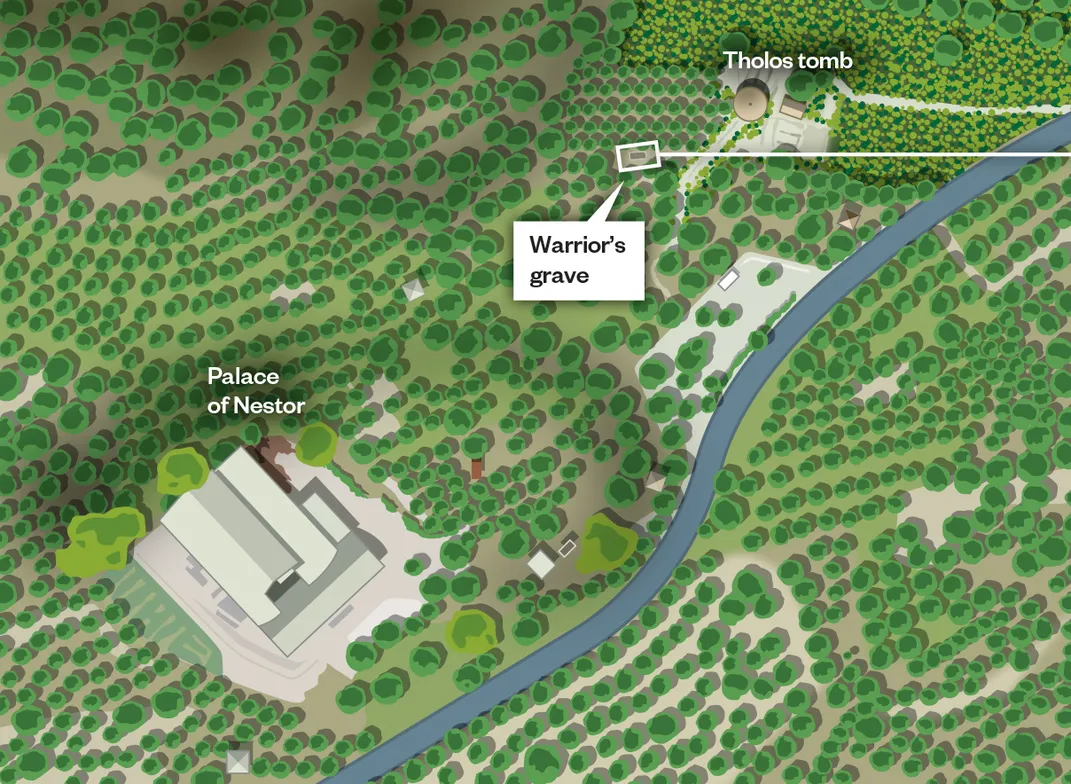
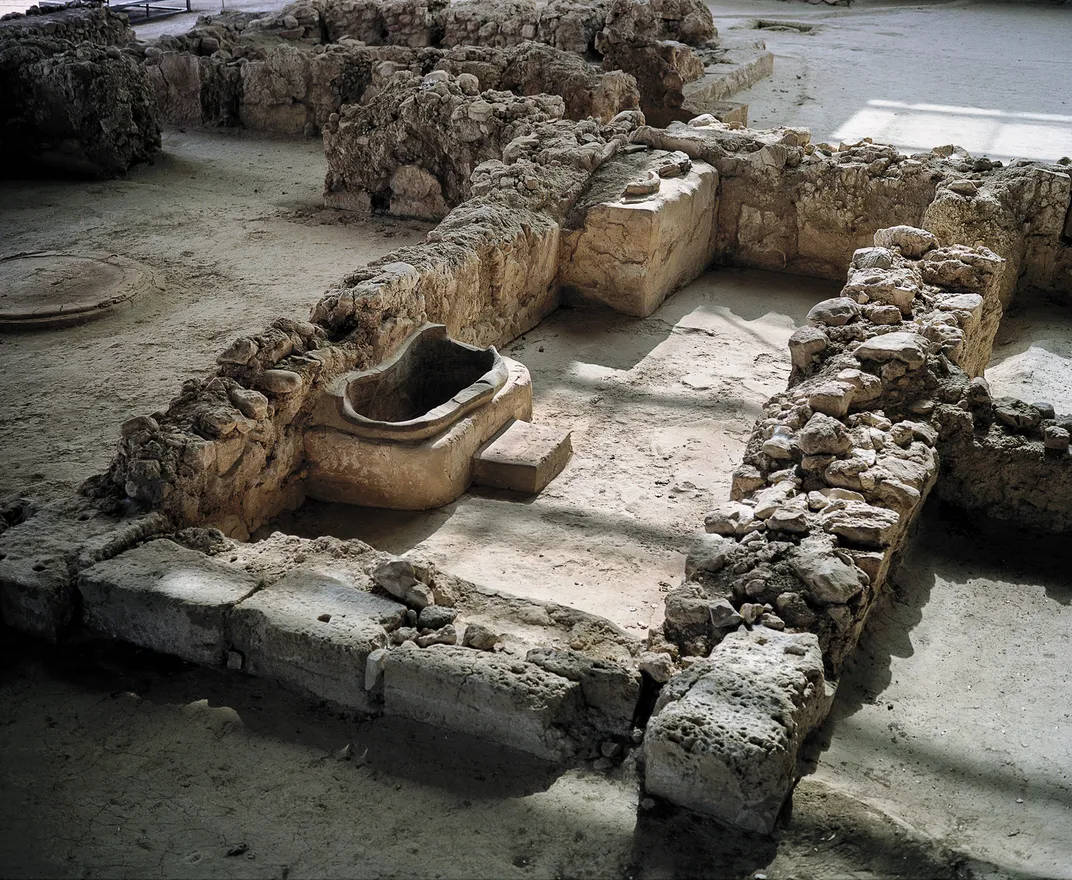
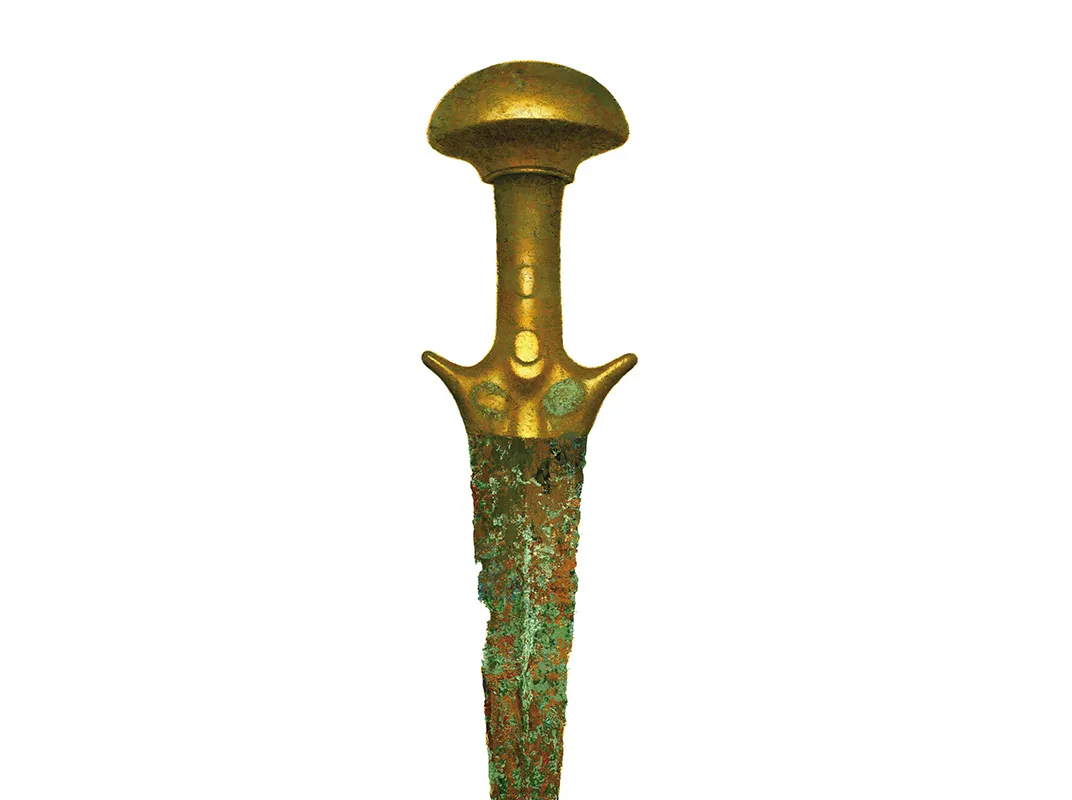
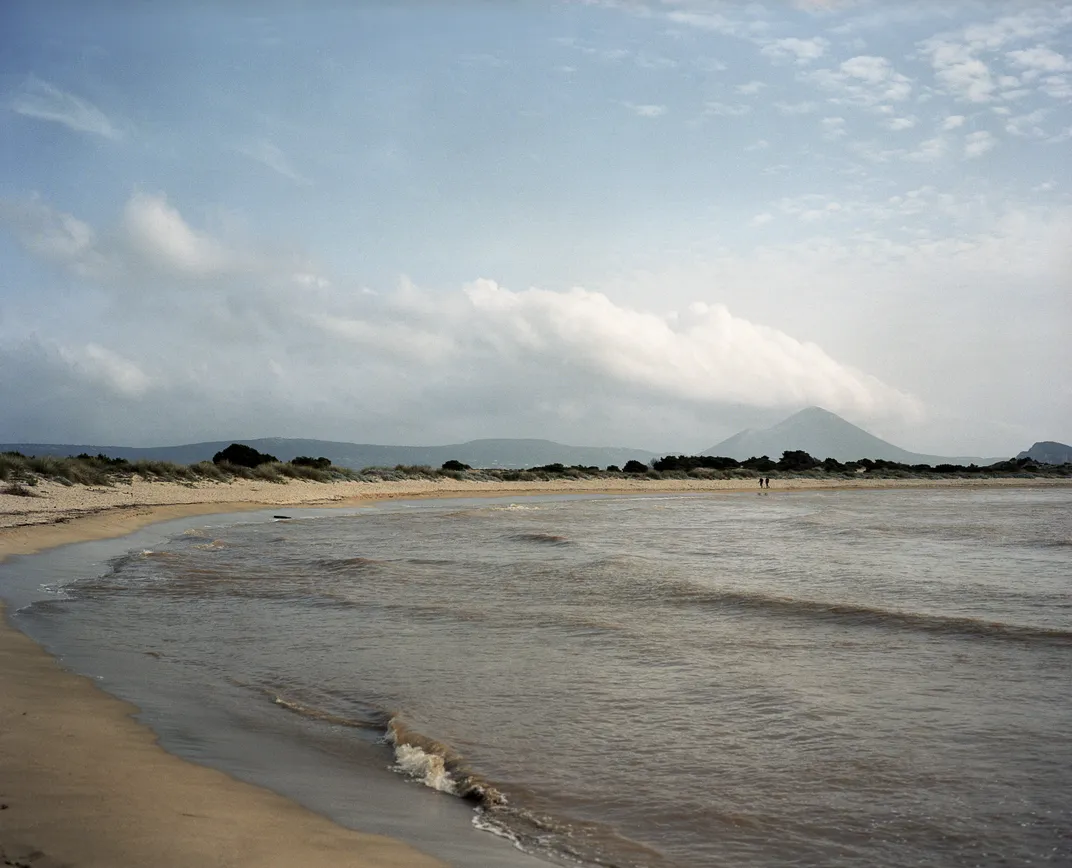

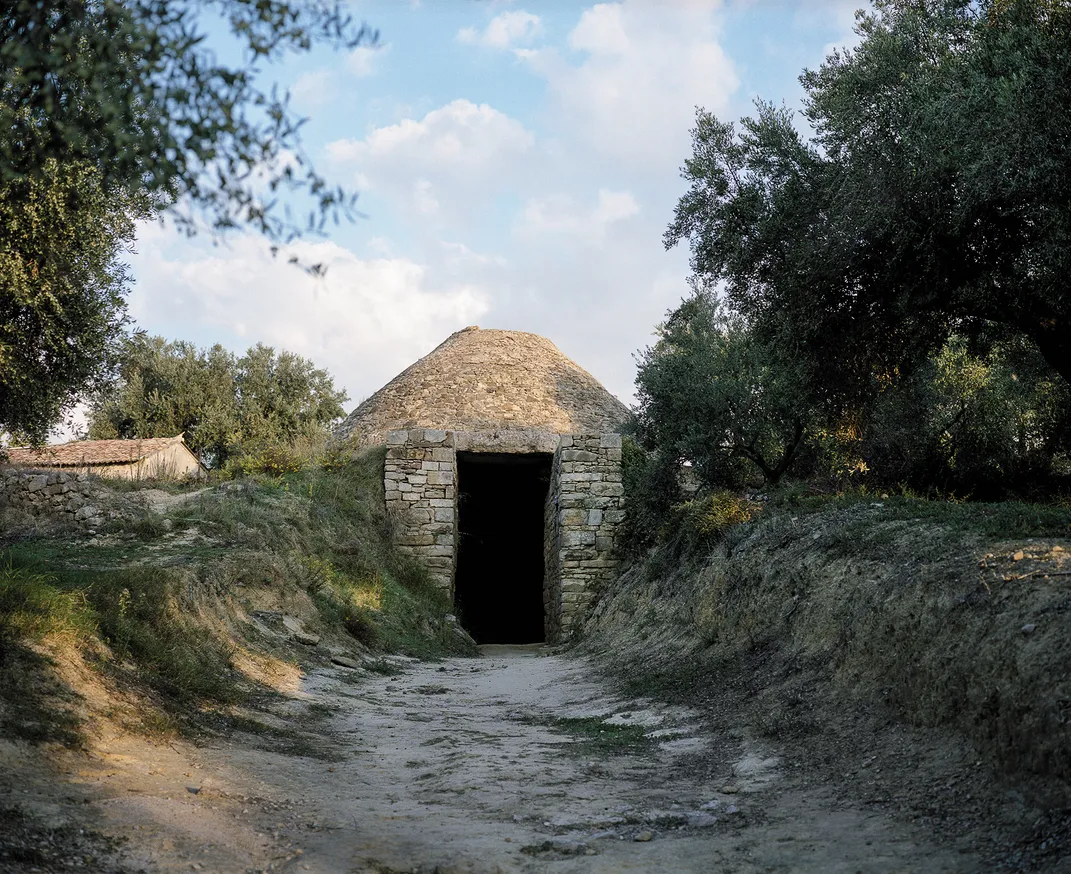
/https://tf-cmsv2-smithsonianmag-media.s3.amazonaws.com/accounts/headshot/Jo.png)